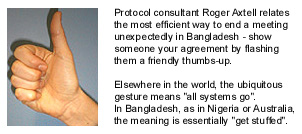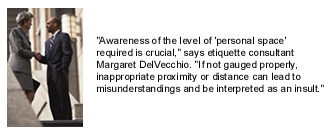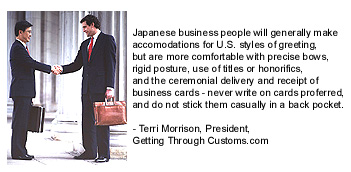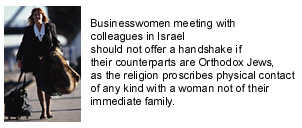|
Body language savvy
|
 |
May 3, 2000: 1:38 p.m. ET
International business deals can fail in a flick of the wrist
By Tatiana D. Helenius
|
NEW YORK (CNNfn) - In the high stakes world of international business, body language often speaks for itself. Unfortunately, much of the meaning may be lost in translation. The most innocuous of gestures - when misinterpreted - can wreak havoc on business negotiations.
In the United States, for example, the "OK" hand gesture conveys enthusiasm or approval of a business associate's suggestion. But flash that sign in France, where it's synonymous with "zero" or "worthless," and your business counterpart might be tempted to close up shop and go home. The same goes in Brazil, where the "OK" sign has prurient significance and is considered vulgar.
International protocol consultant Hilka Klinkenberg of Etiquette International, tells the story of a Brazilian acquaintance who oversees operations for family businesses in the United States and Brazil. "After four years in New York, this young woman still finds it offensive when someone flashes the 'OK' sign. She knows that it means 'OK' here, but it is still disconcerting to her - she is translating body language using her understanding of what that particular gesture means," said Klinkenberg.
Gimme a 'V'
Flashing the "V" sign for victory in the United States suggests business negotiations have concluded well. But that sentiment will be lost on anyone from the U.K., Australia, and New Zealand, if the gesture is made with the back of the hand facing out. You might end up in as much hot water as if you gave a business colleague the friendly thumbs-up in Bangladesh - interpreted there as the not-so-polite way of telling someone to "get stuffed."
 Other gestures may not necessarily give blatant offense, however they may distract or irritate observers. This is particularly true in some Asian countries, where many exchanges depend on nuance and implicit understanding, and gesticulation is kept at a minimum. Using choppy, frequent gestures in pushing your proposal can be viewed as the nonverbal equivalent of idle chatter, according to Klinkenberg. Other gestures may not necessarily give blatant offense, however they may distract or irritate observers. This is particularly true in some Asian countries, where many exchanges depend on nuance and implicit understanding, and gesticulation is kept at a minimum. Using choppy, frequent gestures in pushing your proposal can be viewed as the nonverbal equivalent of idle chatter, according to Klinkenberg.
 Proximity is another relevant issue in business dealings. Proximity is another relevant issue in business dealings.
So relevant, in fact, that numerous psychologists have conducted formal studies on the subject, called proxemics.
Those who have felt uncomfortable in meetings with international clients who stand or sit too close are reacting to a perceived infringement of their personal space, otherwise known as Personal Space Invasion Syndrome, or PSIS.
Alternatively, those more comfortable speaking with colleagues at arm's length or closer may perceive associates who continually distance themselves as untrustworthy.
 Protocol and etiquette consultant Margaret DelVecchio, who added that people do have their own idiosyncratic tendencies, suggested the following general guidelines: Protocol and etiquette consultant Margaret DelVecchio, who added that people do have their own idiosyncratic tendencies, suggested the following general guidelines:
- For most North Americans, a distance of approximately 19 inches, or just about arm's length, between two speakers is considered appropriate.
- For Western Europeans and Americans, a space of 14 to 16 inches is considered non-intrusive. But those from the U.K. might consider a distance of 24 inches to be more comfortable.
- Business owners and corporate executives in Korean and China generally prefer at least that much room, if not more. And their business partners in Japan have a somewhat wider required personal space - in the 36 inches range.
- Lastly, for those in Middle Eastern countries, where a narrower distance of between 8 to 12 inches between speakers is common, widening the distance could be perceived as mistrustful behavior.
"Awareness of the level of personal space required is crucial," said DelVecchio.
"If not gauged properly, inappropriate proximity or distance can lead to misunderstandings and be interpreted as an insult."
Casual dress = casual attitude
Casual dress, a workplace perk acceptable throughout corporate America, is not altogether as common in other parts of the world.
Sloppiness in dress not only makes a bad impression, but it may cause others to question business credentials or reliability.
"In the international arena," said DelVecchio, "the words 'conservative, traditional, and formal' still very much apply. If you are not sure, err on the side of formality. Whether in Europe, Asia, the Middle East, or South America, informality and a careless attitude will scuttle even the most talented executive."
Sloppy speech is just as problematic.
If it's determined among your group that negotiations will be conducted in English, be considerate by avoiding slang terms such as "in the loop," "push the envelope" and "should I CC you on that?" This advice applies to written communications such as faxes, as well.
 Becoming acquainted in advance with cultural differences in introductions and handshakes projects a positive impression. Becoming acquainted in advance with cultural differences in introductions and handshakes projects a positive impression.
"In the U.S., the handshake is most often effusive," said Judith Bowman, protocol consultant, Protocol Consultants International. "There are several pumps of the arm, and a strong grip delivers an unspoken message of confidence. In France, however, one pump is considered sufficient, and the pressure is generally lighter. A light, lingering handshake is generally more favored in Latin America, and to withdraw the hand too quickly could be interpreted as an insult."
It is important to keep in mind that in many cultures, including China and Japan, introductions are made with the last name first. The first name, in fact, is never used in Japan, even in an informal setting, and a formal bow is always part of the initial introduction.
In many countries, there are often social and religious underpinnings that carry through to business interactions; to be aware of these is to show respect for colleagues' cultural backgrounds or expectations.
 In Saudi Arabia, for instance, "Orthodox Muslim men are supposed to ignore females outside their immediate family," said Terri Morrison, president of GettingThroughCustoms.com, "They are not even supposed to inquire about a male friend's female relatives. One should never ask the question 'how is your wife?' in this case, even though it is courteous elsewhere to inquire after a colleagues' family." In Saudi Arabia, for instance, "Orthodox Muslim men are supposed to ignore females outside their immediate family," said Terri Morrison, president of GettingThroughCustoms.com, "They are not even supposed to inquire about a male friend's female relatives. One should never ask the question 'how is your wife?' in this case, even though it is courteous elsewhere to inquire after a colleagues' family."
In India, male colleagues automatically shake hands, but businesswomen make the decision whether or not to extend their hands along with a vocal greeting. Keep in mind, too, that conflict and aggressive negotiation in India is avoided at all cost.
Intercultural subtleties aside, the core of doing business lies in understanding individuals.
"There is one universal action -- the smile -- that is used and understood by every culture, in every country," said DelVecchio. "It can be the most effective form of communication. And in the final analysis, regardless of how skilled or untutored someone is in protocol, the greatest compliment we can pay anyone is a sincere and genuine interest in them and their concerns."
The Golden Rule still applies, she said, "Treat others as you would like to be treated. That's the best business advice of all." 
|
|
|
|
|
|
World Business Today
|
Note: Pages will open in a new browser window
External sites are not endorsed by CNNmoney
|
|
|
|
 |

|

